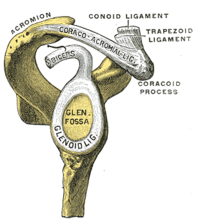
Photo from wikipedia
Abstract Background: The size of the glenoid bone defect is an important index in selecting the appropriate treatment for anterior shoulder instability. However, the reliability of glenoid bone defect measurement… Click to show full abstract
Abstract Background: The size of the glenoid bone defect is an important index in selecting the appropriate treatment for anterior shoulder instability. However, the reliability of glenoid bone defect measurement is controversial. The purpose of the present study was to investigate the reliabilities of measurements of the glenoid bone defect on computed tomography and to explore the predisposing factors leading to inconsistency of these measurements. Methods: The study population comprised 69 consecutive patients who underwent surgery for recurrent anterior shoulder dislocation in Peking University Fourth School of Clinical Medicine from March 2016 to January 2017. The glenoid bone defect was measured by three surgeons on ‘self-confirmed’ and ‘designated’ 3-D en-face views, and repeated after an interval of 3 months. Measurements included the ratio of the defect area to the best-fit circle area, and the ratio of the defect width to the diameter of the best-fit circle. The inter- and intra-observer reliabilities of the measurements were evaluated using intraclass correlation coefficients (ICCs). The maximum absolute inter- and intra-observer differences and the cumulative percentages of cases with inter- and intra-observer differences greater than these respective levels were calculated. Results: Almost all linear defect values were bigger than the areal defect values. The inter-observer ICCs for the areal defect were 0.557 and 0.513 in the ‘self-confirmed’ group and 0.549 and 0.431 in the ‘designated’ group. The inter-observer reliabilities for the linear defect were moderate or fair in the ‘self-confirmed’ group (ICC = 0.446, 0.374) and ‘designated’ group (ICC = 0.402, 0.327). The ICCs for intra-observer measurements were higher than those for inter-observer measurements. The respective maximum inter- and intra-observer absolute differences were 13.9% and 13.2% in the ‘self-confirmed’ group, and 15.8% and 9.8% in the ‘designated’ group. Conclusions: The areal measurement of the glenoid bone defect is more reliable than the linear measurement. The reliability of the glenoid defect areal measurement is moderate or worse, suggesting that a more accurate and objective measurement method is needed in both en-face view and best-fit circle determination. Subjective factors affecting the glenoid bone loss measurement should be minimized.
Journal Title: Chinese Medical Journal
Year Published: 2019
Link to full text (if available)
Share on Social Media: Sign Up to like & get
recommendations!